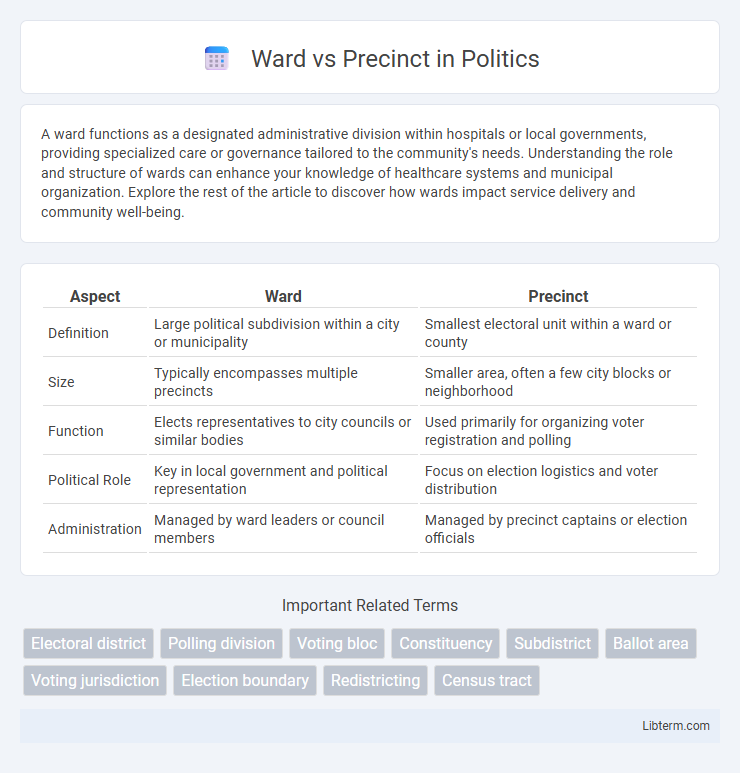A ward functions as a designated administrative division within hospitals or local governments, providing specialized care or governance tailored to the community's needs. Understanding the role and structure of wards can enhance your knowledge of healthcare systems and municipal organization. Explore the rest of the article to discover how wards impact service delivery and community well-being.
Table of Comparison
| Aspect | Ward | Precinct |
|---|---|---|
| Definition | Large political subdivision within a city or municipality | Smallest electoral unit within a ward or county |
| Size | Typically encompasses multiple precincts | Smaller area, often a few city blocks or neighborhood |
| Function | Elects representatives to city councils or similar bodies | Used primarily for organizing voter registration and polling |
| Political Role | Key in local government and political representation | Focus on election logistics and voter distribution |
| Administration | Managed by ward leaders or council members | Managed by precinct captains or election officials |
Understanding the Concepts: Ward vs Precinct
A ward is a larger political subdivision within a city or municipality used for electing council members, while a precinct is a smaller voting district primarily used to organize polling locations for elections. Wards encompass multiple precincts, serving broader administrative and electoral functions, whereas precinct boundaries are designed to manage voter distribution efficiently. Understanding the distinction is essential for grasping local governance structures and electoral processes.
Historical Background of Wards and Precincts
Wards originated in medieval cities as administrative divisions designed to manage local governance and taxation effectively. Precincts evolved later as smaller electoral units within wards, helping organize polling stations and voting processes. Both structures have historical roots in maintaining order and representation in urban political systems.
Key Differences Between Wards and Precincts
Wards are larger administrative divisions within a city or municipality, often comprising multiple precincts, and are used primarily for electoral representation and local governance. Precincts serve as smaller geographic units focused on organizing voters and managing election logistics such as polling locations and voter registration. The key difference lies in their scope and function: wards represent political subdivisions for council representation, while precincts are fundamental units for election administration and voter management.
Roles and Functions of Wards
Wards serve as administrative divisions within cities, primarily facilitating local governance and political representation, often encompassing multiple precincts. Their roles include organizing community services, managing local elections by coordinating precinct activities, and serving as a liaison between residents and municipal government. Wards also play a crucial role in resource allocation and policy implementation to address neighborhood-specific needs effectively.
Roles and Functions of Precincts
Precincts serve as the smallest administrative units in local government, primarily responsible for organizing and managing voter registration, polling locations, and election day operations. They facilitate community engagement by connecting residents with local officials and ensuring effective communication during elections and civic activities. Precincts also support law enforcement and public safety by defining jurisdictional boundaries for police patrols and emergency response.
Ward and Precinct Boundaries Explained
Ward boundaries define larger electoral districts within a city or municipality, often encompassing multiple neighborhoods for governance and representation purposes. Precinct boundaries are smaller, more localized divisions within wards, established primarily to organize voting locations and manage local elections efficiently. Understanding the distinction between ward and precinct boundaries is crucial for accurate voter registration, political representation, and election administration.
How Wards and Precincts Impact Elections
Wards and precincts divide electoral regions to organize voting processes and ensure accurate representation in elections. Wards typically encompass multiple precincts, influencing resource allocation and voter outreach strategies for political campaigns. Precincts, as the smallest voting units, directly impact election outcomes by determining polling locations and facilitating efficient voter management.
Ward and Precinct Organization Structures
Ward and precinct organization structures serve distinct roles in local political administration; wards are larger divisions that encompass multiple precincts and are typically used for electoral districting and representation purposes. Precincts, as the smallest electoral units, function as fundamental operational zones for voter registration, polling locations, and grassroots campaigning. Understanding the hierarchical relationship between wards and precincts is crucial for effective political mobilization and resource allocation within municipal governance.
Redistricting: Changes in Wards and Precincts
Redistricting involves redefining political boundaries, often altering the size and shape of wards and precincts to reflect population changes and maintain equal representation. Wards, typically larger political divisions, may be split or combined, impacting the configuration of smaller precincts within them. Adjustments in these boundaries influence voting districts, local governance, and resource allocation, making precise redistricting critical for fair and effective electoral processes.
Importance of Wards and Precincts in Local Governance
Wards and precincts play a crucial role in organizing local governance by dividing municipalities into manageable geographic units for electoral and administrative purposes. Wards serve as larger electoral districts represented by council members, ensuring residents' interests are directly voiced in city councils. Precincts function as smaller subdivisions within wards, facilitating efficient voter registration, polling station management, and accurate election results, thereby strengthening democratic participation at the grassroots level.
Ward Infographic

 libterm.com
libterm.com